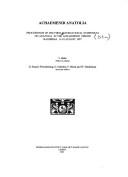| Listing 1 - 10 of 40 | << page >> |
Sort by
|
Book
ISBN: 9751600804 9751600863 9789751600806 9751600855 9789751600851 9789751600868 Year: 1991 Publisher: Ankara : Türk Tarih Kurumu Basımevi,
Abstract | Keywords | Export | Availability | Bookmark
Book
ISBN: 9781784531652 Year: 2015 Publisher: London : I.B. Tauris,
Abstract | Keywords | Export | Availability | Bookmark
 Loading...
Loading...Choose an application
- Reference Manager
- EndNote
- RefWorks (Direct export to RefWorks)
"Under Seljuk rule (c. 1081-1308) the formerly Christian Byzantine territories of Anatolia were transformed by the development of Muslim culture, society and politics, and it was then - well before the arrival of the Ottomans - that a Turkish population became firmly established in these lands. But these developments are little understood, and the Seljuk dynasty remains little studied. Yet the Seljuks of Anatolia were one of the most influential dynasties of the thirteenth-century Middle East, controlling some of the major trade routes of the period, playing a crucial role in linking East and West of the medieval world. This volume examines Seljuk culture and history by looking at developments both at court and in society at large and shed new light on Seljuk political culture and dynastic ideology, the engagement of politics with religion, and Christian-Muslim interaction. The Seljuks of Anatolia will be of great interest to researchers with interests in Byzantium as well as the material culture and society of the medieval Islamic world."--Page [4] of cover.

Abstract | Keywords | Export | Availability | Bookmark
 Loading...
Loading...Choose an application
- Reference Manager
- EndNote
- RefWorks (Direct export to RefWorks)
Istanbul (Turkey) --- Istanbul (Turquie) --- History --- Social life and customs. --- Histoire --- Moeurs et coutumes --- To 1453
Book
ISBN: 9783406508646 3406508642 Year: 2007 Publisher: München: Beck,
Abstract | Keywords | Export | Availability | Bookmark
 Loading...
Loading...Choose an application
- Reference Manager
- EndNote
- RefWorks (Direct export to RefWorks)
Archaeology - Turkey - Istanbul --- Istanbul (Turkey) - History - To 1453 --- Archaeology --- Istanbul (Turkey) --- History
Book
ISBN: 9780415505406 0415505402 Year: 2014 Publisher: New York : Routledge,
Abstract | Keywords | Export | Availability | Bookmark
 Loading...
Loading...Choose an application
- Reference Manager
- EndNote
- RefWorks (Direct export to RefWorks)
Seljuks --- Seljuks. --- History. --- To 1453. --- Turkey --- Islamic Empire --- Islamic Empire. --- Turkey. --- History
Book
ISBN: 9781789250077 9781789250084 9781789250091 9781789250107 1789250072 1789250080 1789250102 Year: 2019 Publisher: Oxford
Abstract | Keywords | Export | Availability | Bookmark
 Loading...
Loading...Choose an application
- Reference Manager
- EndNote
- RefWorks (Direct export to RefWorks)
Asia Minor is considered to have been a fairly prosperous region in Late Antiquity. It was rarely disturbed by external invasions and remained largely untouched by the continuous Roman-Persian conflict until very late in the period, was apparently well connected to the flourishing Mediterranean economy and, as the region closest to Constantinople, is assumed to have played an important part in the provisioning of the imperial capital and the imperial armies.0When exactly this prosperity came to an end - the late sixth century, the early, middle or even later seventh century - remains a matter of debate. Likewise, the impact of factors such as the dust veil event of 536, the impact of the bubonic plague that made its first appearance in AD 541/542, the costs and consequences of Justinian's wars, the Persian attacks of the early seventh century and, eventually the Arab incursions of around the middle of the seventh century, remains controversial. The more general living conditions in both cities and countryside have long been neglected. The majority of the population, however, did not live in urban but in rural contexts. Yet the countryside only found its proper place in regional overviews in the last two decades, thanks to an increasing number of regional surveys in combination with a more refined pottery chronology. Our growing understanding of networks of villages and hamlets is very likely to influence the appreciation of the last decades of Late Antiquity drastically. Indeed, it would seem that the sixth century in particular is characterised not only by a ruralisation of cities, but also by the extension and flourishing of villages in Asia Minor, the Roman Near East and Egypt.
Antiquities. --- To 1453. --- Turkey --- Turkey. --- History --- Cities and towns, Ancient --- Material culture --- Economic conditions --- Archaeological specimens --- Artefacts (Antiquities) --- Artifacts (Antiquities) --- Specimens, Archaeological --- Archaeology --- To 1453 --- Asie Mineure --- Turquie --- Histoire. --- Antiquit�es.

ISBN: 9062580939 9789062580934 Year: 2001 Volume: 92 Publisher: Leiden: Nederlands instituut voor het Nabije Oosten,
Abstract | Keywords | Export | Availability | Bookmark
 Loading...
Loading...Choose an application
- Reference Manager
- EndNote
- RefWorks (Direct export to RefWorks)
Achaemenid dynasty, --- Turkey --- History --- Antiquities --- Achaemenid dynasty, - 559-330 B.C. --- Turkey - History - To 1453 --- Turkey - Antiquities --- Antiquities.
Book
ISBN: 9780674724815 067472481X Year: 2013 Volume: 24 Publisher: Cambridge (Mass.): Harvard university press,
Abstract | Keywords | Export | Availability | Bookmark
 Loading...
Loading...Choose an application
- Reference Manager
- EndNote
- RefWorks (Direct export to RefWorks)
The Patria is a fascinating four-book collection of short historical notes, stories, and legends about the buildings and monuments of Constantinople, compiled in the late tenth century by an anonymous author who made ample use of older sources. It also describes the foundation and early (pre-Byzantine) history of the city, and includes the Narrative on the Construction of Hagia Sophia, a semi-legendary account of Emperor Justinian I’s patronage of this extraordinary church (built between 532 and 537). The Patria constitutes a unique record of popular traditions about the city, especially its pagan statues, held by its medieval inhabitants. At the same time it is the only Medieval Greek text to present a panorama of the city as it existed in the middle Byzantine period. Despite its problems of historical reliability, the Patria is still one of our main guides for the urban history of medieval Constantinople. This translation makes the entire text of the Patria accessible in English for the first time.
Greeks --- History. --- Istanbul (Turkey) --- History --- Ethnology --- Mediterranean race --- Greeks - Turkey - Istanbul - History --- Istanbul (Turkey) - History - To 1453
Book
ISBN: 9789545354977 9545354976 Year: 2008 Publisher: Sofija : Nov bǎlgarski universitet,
Abstract | Keywords | Export | Availability | Bookmark
 Loading...
Loading...Choose an application
- Reference Manager
- EndNote
- RefWorks (Direct export to RefWorks)
Russes --- Russians --- Russians. --- To 1453. --- Byzantine Empire --- Byzantine Empire. --- Empire byzantin --- Istanbul (Turkey) --- Turkey --- İstanbul (Turquie) --- History. --- Histoire. --- History --- Histoire
Book
ISBN: 904294885X Year: 2021 Publisher: Leuven : Peeters Publishers & Booksellers,
Abstract | Keywords | Export | Availability | Bookmark
 Loading...
Loading...Choose an application
- Reference Manager
- EndNote
- RefWorks (Direct export to RefWorks)
"This book contains the proceedings of an international conference with a focus on Anatolia in the first millennium BC which took place on Monte Verita, Ascona in Switzerland, in 2018. The volume contains recent and thought-provoking research from diverse academic fields, bringing together historical, linguistic and archaeological lines of enquiry. The aim of the conference, to stimulate interdisciplinary debate and to close ever widening gaps between related fields, also motivates this volume. Thirty-one chapters in three languages address Anatolian matters "Beyond All Boundaries" and present an essential contribution to the study of historical developments not only in Anatolia, but also in the neighbouring regions and the whole Mediterranean area in the first millennium BC."
Excavations (Archaeology) --- Cities and towns, Ancient --- Anatolian languages. --- To 1453 --- Turkey --- Turkey. --- Asia Minor. --- Antiquities. --- History --- Antiquities
| Listing 1 - 10 of 40 | << page >> |
Sort by
|

 Search
Search Feedback
Feedback About UniCat
About UniCat  Help
Help News
News